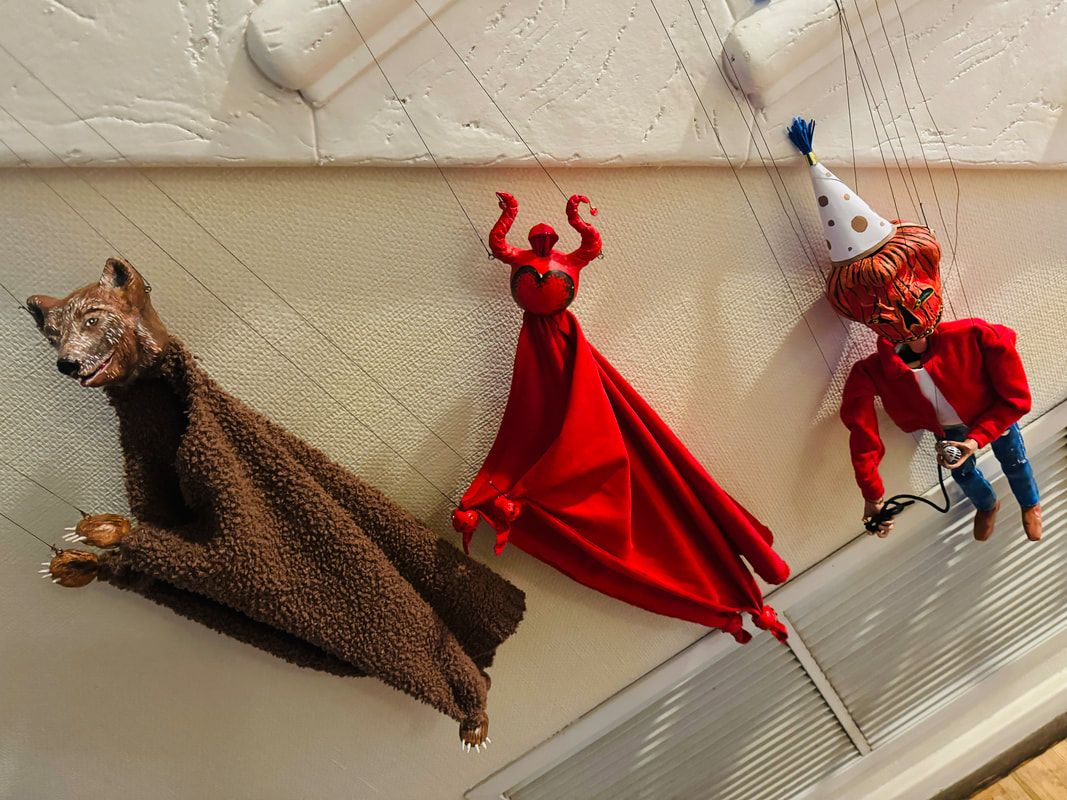|
“There’s an article I think you should read,” my husband Kevin offers, somewhat tentatively, over coffee and tea. He knows from experience that my attention span is short -- there’s about a 50% chance I’ll finish (or even open) what he emails for me to read. Not because I don’t want to. I just…get distracted. “What’s it about?” “Neo-romanticism.” I don’t take the bait immediately, and the morning goes on. But the phrase sticks in my head and in the afternoon I circle back: “What about that article made you think I should read it?” “It reminded me of your puppets.” Now he has my attention. The article will almost certainly be read. And by the next day, it is: The zeitgeist is changing. A strange, romantic backlash to the tech era looms. By Ross Barkan For the last two years I have been falling, at an increasingly rapid rate, down a very particular rabbit hole: marionettes. I built my first one in 2022 for a children’s video series, and it was love-at-first-string. Making puppets co-mingles all my passions, allowing me to exercise every single muscle I’ve tried to develop over the last 25 years. From the visual arts of sketching, sculpting and painting, to writing music and dialogue, costume and set construction, problem solving and mechanical engineering (a new discovery for me) and finally performance – in the tiny world of marionettes I can test my mettle as an auteur. I’m not a fan of that word, but the alternative “control-freak” is even less appealing. And I think that in my creative life it’s what I’ve always wanted to be. The world-builder. God. We all seek out agency, control, power in our own ways, don’t we? Many years of enjoying the Bob Baker Marionettes prompted the question “I wonder if I could do that?” I found that I could, and relished pretty much every part of the process. But the delighted look on people’s faces when they see what I’ve built is a major, unexpected perk. Over the last year, in addition to succumbing to the gravity of my puppet-flavored rabbit hole, I’ve come to accept that I’m really a live performer. A 6-month stint at the Utah Shakespeare Festival – my first time in a repertory company since 2014 – reminded me that there is no substitution for the thrilling terror I feel before stepping onto the stage. I’ll always be an actor. I’ll always say yes to a chance to shape characters with my whole being. It’s an exhausting, dangerous and thrilling thing to do – trying to just live in front of a room full of people. But puppetry is acting with a mask (a fact my friend and fellow actor Ramiz Monsef pointed out to me last year). I find this extremely appealing. Masking removes traces of self-consciousness, doubt and ego. It frees your consciousness to flow entirely into the tiny creature dangling from your fingers. You’re here, now. YouTuber Byrne Power has a video on his puppet channel entitled “How to Start a Puppet Theatre or Puppet Troupe – Instructions for a Reality Based Art” in which he asserts that most people in the US have never seen a live marionette show. Enviably, Byrne has spent a lot of time in Europe and other parts of the world where puppetry gets real attention and thrives as an envelope-pushing art form. But in the US broad exposure is limited to the (brilliant) muppets of Jim Henson. The names of marionette artists such as Hobey Ford, Jim Cashore and Phillip Huber are not widely recognized beyond the puppet world. Their live performances are hard to see unless you live or happen to be in the particular part of the country where they’re based (and now Mr. Cashore is retired so I fear I’ve lost my chance entirely). Investigating the record of marionettes in America led me to incredible work by master puppeteers and troupes that I had never heard of – Tony Sarg, Rufus and Margo Rose, the Yale Puppeteers, René Zendejas, just to name a few. In the distant past, puppets had a place on vaudeville stages, and even early film and television -- explaining coffee production, importation and packaging for the American Can Company and hawking washing machines for RCA Whirlpool, for instance. So there is rich history. But I feel the truth of what Byrne said in his video: in the US of the 21st century, marionette performance is a vanishingly rare art form. Kevin and I were married in Missoula, Montana (his home for the last 10+ years) in late October, 2023. He knew I was eager to get my puppets out in the world but had been nervous to do so. It felt like a big step, busking for the first time at the age of 40; somehow all the live theater in formal playhouses before paying audiences just wasn’t the same. In broad daylight, on a street corner, people can wander up and talk to you, touch the wiggly thing on strings, interact, walk away in the middle of it. The rules just aren’t the same. Even from behind the ‘mask’ I wasn’t sure if I’d be able to handle it, and it both excited and terrified me. So Kevin suggested a gentle entrée to the world of street performance: walk with the puppets in the Día de Los Muertos parade on November 2nd. “Great!” I thought. The focus wouldn’t really be on us at all. It would be a chance to offer up what I’d been working on to the community in a spirit of celebration and remembrance. And a way for me to honor the life of Maila Nurmi, creator of Vampira, the inspiration for one of my new marionettes. It was all of those things, but it ended up being more. Kevin rigged a speaker to his chest so our puppets had their own music to dance and lip-synch to. Face after face lit up. Parents led shy children over to us and whispered “See? It’s a marionette!”, and I knew many were hearing the word for the first time. Some kids were weirded out, even frightened at first. But most came around for another peek and lingered. Others were instantly mesmerized. Friends and family have suggested I start an Instagram page or make TikTok videos. I’ve given it thought. “Maybe I could develop enough of a following to monetize!” But my gut consistently offers a hard ‘no’ in response. There is something intrinsic to this that demands the live experience. Like the neo-romantics heralded by Ross Barkan, I am engaging in an act of rebellion. Choosing to live at least this part of my life off-screen. My marionette obsession is an atavistic one. When I pull these strings I’m connecting to artists across space and time. Through their creations, I’ve come to know the minds of people who were gone before I ever arrived. To audiences in the present I’m offering a reality that can only be experienced here and now, where and whenever “here” and “now” are – a black box theater, a streetcorner, a parade. I think there’s something sacred in that. It’s small enough to swing from my fingers, but far larger than the video player in the palm of your hand.
0 Comments
Leave a Reply. |
Archives
July 2024
CategoriesFind me on YouTube! |
Proudly powered by Weebly


 RSS Feed
RSS Feed